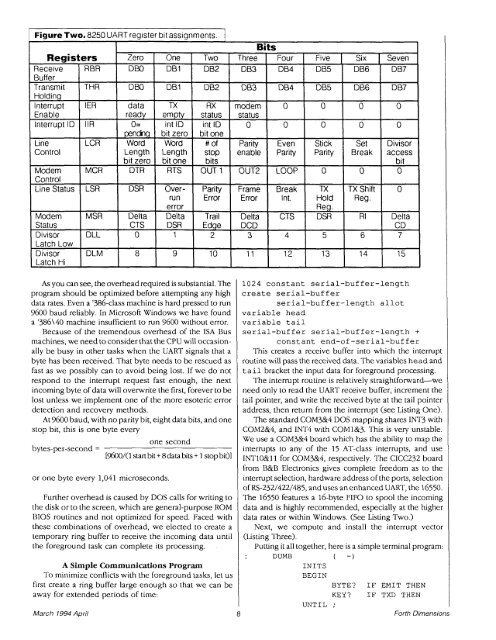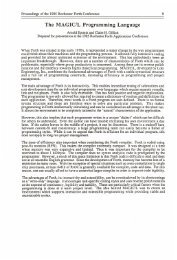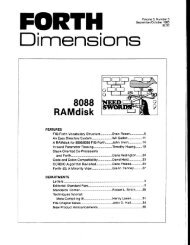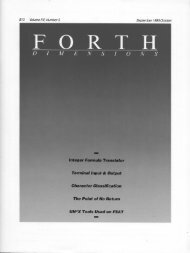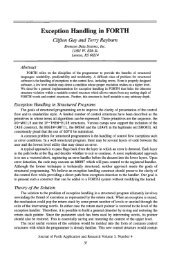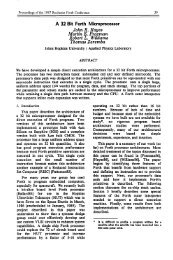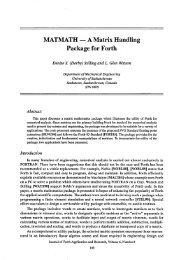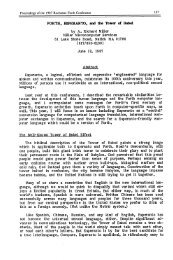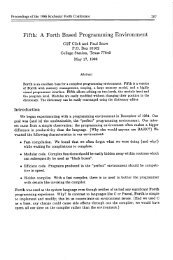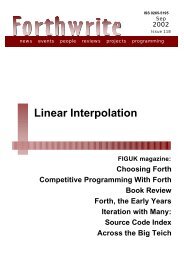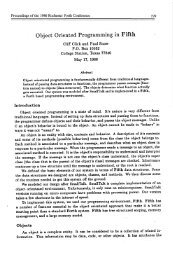FAST Forth Native-Language Embedded Computers
FAST Forth Native-Language Embedded Computers
FAST Forth Native-Language Embedded Computers
You also want an ePaper? Increase the reach of your titles
YUMPU automatically turns print PDFs into web optimized ePapers that Google loves.
Figure - Two. 8250 UART reqister - bit assianments. - 11<br />
Registers<br />
Receive RBR<br />
Buffer<br />
Transmit THR<br />
Holding<br />
Interrupt IER<br />
Enable<br />
Interrupt ID IIR<br />
Line<br />
Control<br />
Modem<br />
Control<br />
Line Status<br />
Modem<br />
Status<br />
Divisor<br />
Latch Low<br />
Divisor<br />
Latch Hi<br />
LCR<br />
MCR<br />
LSR<br />
MSR<br />
D LL<br />
DLM<br />
Zero<br />
DBO<br />
DBO<br />
data<br />
ready<br />
O=<br />
pen-<br />
Word<br />
Length<br />
bit zero<br />
DTR<br />
DSR<br />
Delta<br />
CTS<br />
0<br />
8<br />
One<br />
DB 1<br />
DB1<br />
TX<br />
empty<br />
int ID<br />
bit zero<br />
Word<br />
Length<br />
bit one<br />
RTS<br />
Overrun<br />
error<br />
Delta<br />
DSR<br />
1<br />
9<br />
Two<br />
DB2<br />
DB2<br />
RX<br />
status<br />
int ID<br />
bit one<br />
#of<br />
stop<br />
bits<br />
OUT 1<br />
Parity<br />
Error<br />
Trail<br />
Edge<br />
2<br />
10<br />
Three<br />
DB3<br />
DB3<br />
modem<br />
status<br />
0<br />
Parity<br />
enable<br />
OUT2<br />
Frame<br />
Error<br />
Delta<br />
DCD<br />
3<br />
11<br />
Bits<br />
Four<br />
DB4<br />
DB4<br />
0<br />
0<br />
Even<br />
Parity<br />
LOOP<br />
Break<br />
Int.<br />
CTS<br />
4<br />
12<br />
Five<br />
DB5<br />
DB5<br />
0<br />
0<br />
Stick<br />
Parity<br />
0<br />
TX<br />
Hold<br />
Reg.<br />
DSR<br />
5<br />
13<br />
Six<br />
DB6<br />
DB6<br />
0<br />
0<br />
Set<br />
Break<br />
0<br />
TX Shift<br />
Reg.<br />
RI<br />
6<br />
14<br />
Seven<br />
DB7<br />
DB7<br />
0<br />
0<br />
Divisor<br />
access<br />
bit<br />
0<br />
0<br />
Delta<br />
CD<br />
7<br />
15<br />
As you cansee, theoverheadrequiredissubstantial.The<br />
program should be optimized before attempting any high<br />
data rates. Even a '386-class machine is hard pressed to run<br />
7600 baud reliably. In Microsoft Windows we have found<br />
a '386\40 machine insufficient to run 7600 without error.<br />
Because of the tremendous overhead of the ISA Bus<br />
machines, we need to consider that the CPU will occasionally<br />
be busy in other tasks when the UART signals that a<br />
byte has been received. That byte needs to be rescued as<br />
fast as we possibly can to avoid being lost. If we do not<br />
respond to the interrupt request fast enough, the next<br />
incoming byte of data will overwrite the first, forever to be<br />
lost unless we implement one of the more esoteric error<br />
detection and recovery methods.<br />
At 7600 baud, with no parity bit, eight data bits, and one<br />
stop bit, this is one byte every<br />
one second<br />
bytes-per-second =<br />
[W/(l start bit+ 8databirs+<br />
or one byte every 1,041 microseconds.<br />
Further overhead is caused by DOS calls for writing to<br />
the disk or to the screen, which are general-purpose ROM<br />
BIOS routines and not optimized for speed. Faced with<br />
these combinations of overhead, we elected to create a<br />
temporary ring buffer to receive the incoming data until<br />
the foreground task can complete its processing.<br />
A Simple Communications Program<br />
TO minimize conflicts with the foreground tasks, let us<br />
first create a ring buffer large enough so that we can be<br />
away for extended periods of time:<br />
March 1994 April<br />
1024 constant serial-buff er-length<br />
create serial-buf f er<br />
serial-buffer-length allot<br />
variable head<br />
variable tail<br />
serial-buf f er serial-buf f er-length +<br />
constant end-of-serial-buffer<br />
This creates a receive buffer into which the interrupt<br />
routine will pass the received data. The variables head and<br />
tail bracket the input data for foreground processing.<br />
The interrupt routine is relatively straightforward-we<br />
need only to read the UART receive buffer, increment the<br />
tail pointer, and write the received byte at the tail pointer<br />
address, then return from the interrupt (see Listing One).<br />
The standard COM3&4 DOS mapping shares INT3 with<br />
COM2&4, and INT4 with COM1&3. This is very unstable.<br />
We use a COM3&4 board which has the ability to map the<br />
interrupts to any of the 15 AT-class interrupts, and use<br />
INT10&11 for COM3&4, respectively. The CICC232 board<br />
from B&B Electronics gives complete freedom as to the<br />
interrupt selection, hardware address of the ports, selection<br />
of RS-232/422/485, and uses an enhanced UART, the 16550.<br />
The 16550 features a 16-byte FIFO to spool the incoming<br />
data and is highly recommended, especially at the higher<br />
data rates or within Windows. (See Listing Two.)<br />
Next, we compute and install the interrupt vector<br />
(Listing Three).<br />
Putting it all together, here is a simple terminal program:<br />
DUMB ( -1<br />
INITS<br />
BEGIN<br />
BYTE IF EMIT THEN<br />
KEY IF TXD THEN<br />
UNTIL ;<br />
8 <strong>Forth</strong> Dimensions


